Page 2855 of 3383
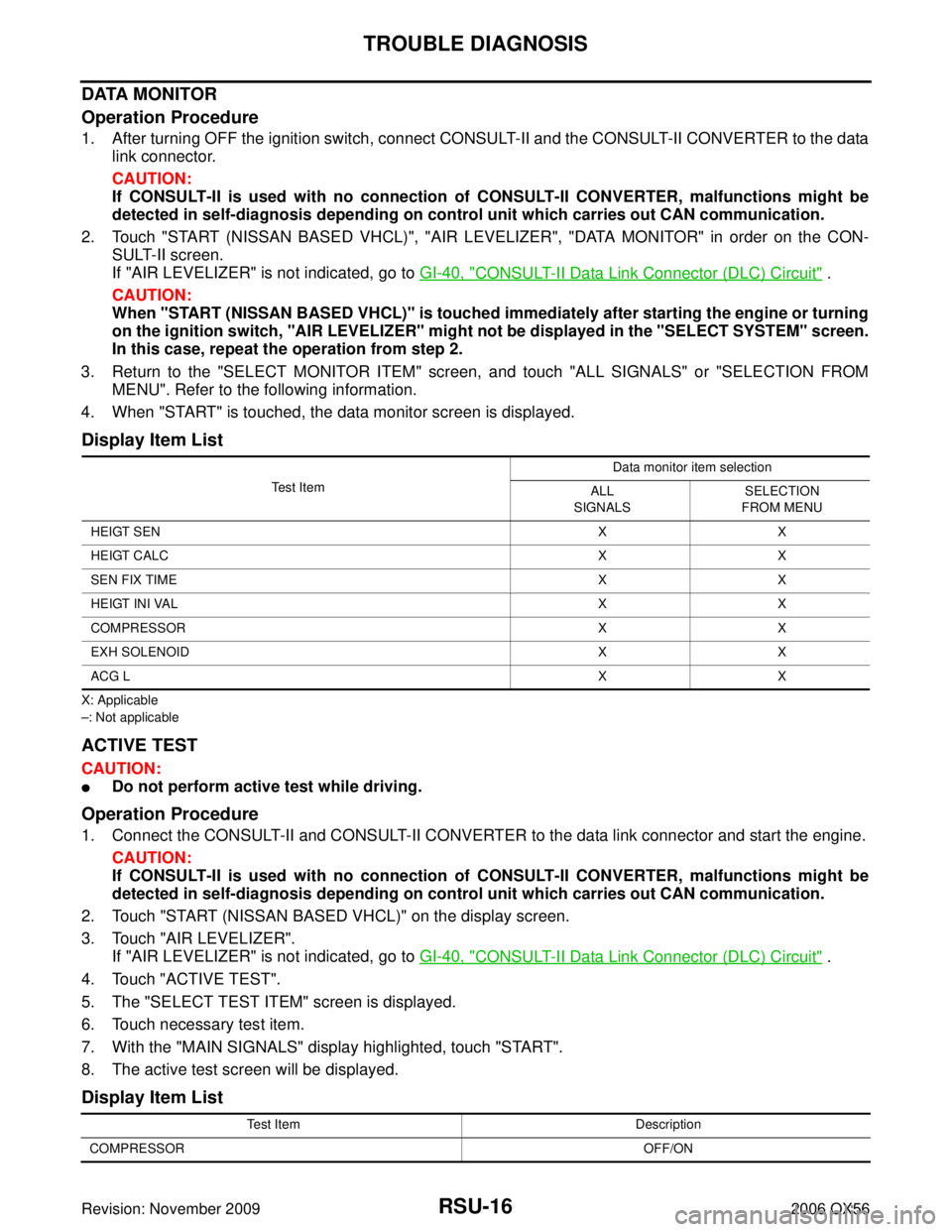
RSU-16
TROUBLE DIAGNOSIS
Revision: November 20092006 QX56
DATA MONITOR
Operation Procedure
1. After turning OFF the ignition switch, connect CONSULT-II and the CONSULT-II CONVERTER to the data
link connector.
CAUTION:
If CONSULT-II is used with no connection of CONSULT-II CONVERTER, malfunctions might be
detected in self-diagnosis depending on control unit which carries out CAN communication.
2. Touch "START (NISSAN BASED VHCL)", "AIR LEVELIZER", "DATA MONITOR" in order on the CON- SULT-II screen.
If "AIR LEVELIZER" is not indicated, go to GI-40, "
CONSULT-II Data Link Connector (DLC) Circuit" .
CAUTION:
When "START (NISSAN BASED VHCL)" is touched immediately after starting the engine or turning
on the ignition switch, "AIR LEVELIZER" might not be displayed in the "SELECT SYSTEM" screen.
In this case, repeat the operation from step 2.
3. Return to the "SELECT MONITOR ITEM" screen, and touch "ALL SIGNALS" or "SELECTION FROM MENU". Refer to the following information.
4. When "START" is touched, the data monitor screen is displayed.
Display Item List
X: Applicable
– : Not applicable
ACTIVE TEST
CAUTION:
�Do not perform active test while driving.
Operation Procedure
1. Connect the CONSULT-II and CONSULT-II CONVERTER to the data link connector and start the engine.
CAUTION:
If CONSULT-II is used with no connection of CONSULT-II CONVERTER, malfunctions might be
detected in self-diagnosis depending on control unit which carries out CAN communication.
2. Touch "START (NISSAN BASED VHCL)" on the display screen.
3. Touch "AIR LEVELIZER". If "AIR LEVELIZER" is not indicated, go to GI-40, "
CONSULT-II Data Link Connector (DLC) Circuit" .
4. Touch "ACTIVE TEST".
5. The "SELECT TEST ITEM" screen is displayed.
6. Touch necessary test item.
7. With the "MAIN SIGNALS" display highlighted, touch "START".
8. The active test screen will be displayed.
Display Item List
Test Item Data monitor item selection
ALL
SIGNALS SELECTION
FROM MENU
HEIGT SEN XX
HEIGT CALC XX
SEN FIX TIME XX
HEIGT INI VAL XX
COMPRESSOR XX
EXH SOLENOID XX
ACG L XX
Test ItemDescription
COMPRESSOR OFF/ON
Page 2856 of 3383
TROUBLE DIAGNOSISRSU-17
C
DF
G H
I
J
K L
M A
B
RSU
Revision: November 2009 2006 QX56
CAUTION:
The "COMPRESSOR" active test will remain ON until it is turned off using CONSULT-II. Allowing the
compressor to run for an extended period of time may cause damage to air suspension system com-
ponents due to excessive pressure in the air suspension system.
NOTE:
�"TEST IS STOPPED" is displayed approximately 10 seconds after operation starts for all active test items
except "COMPRESSOR".
�After "TEST IS STOPPED" is displayed, to perform test again, repeat Step 6.
EXHAUST SOLENOIDOFF/ON
WARNING LAMP OFF/ON
Test Item
Description
Page 2857 of 3383
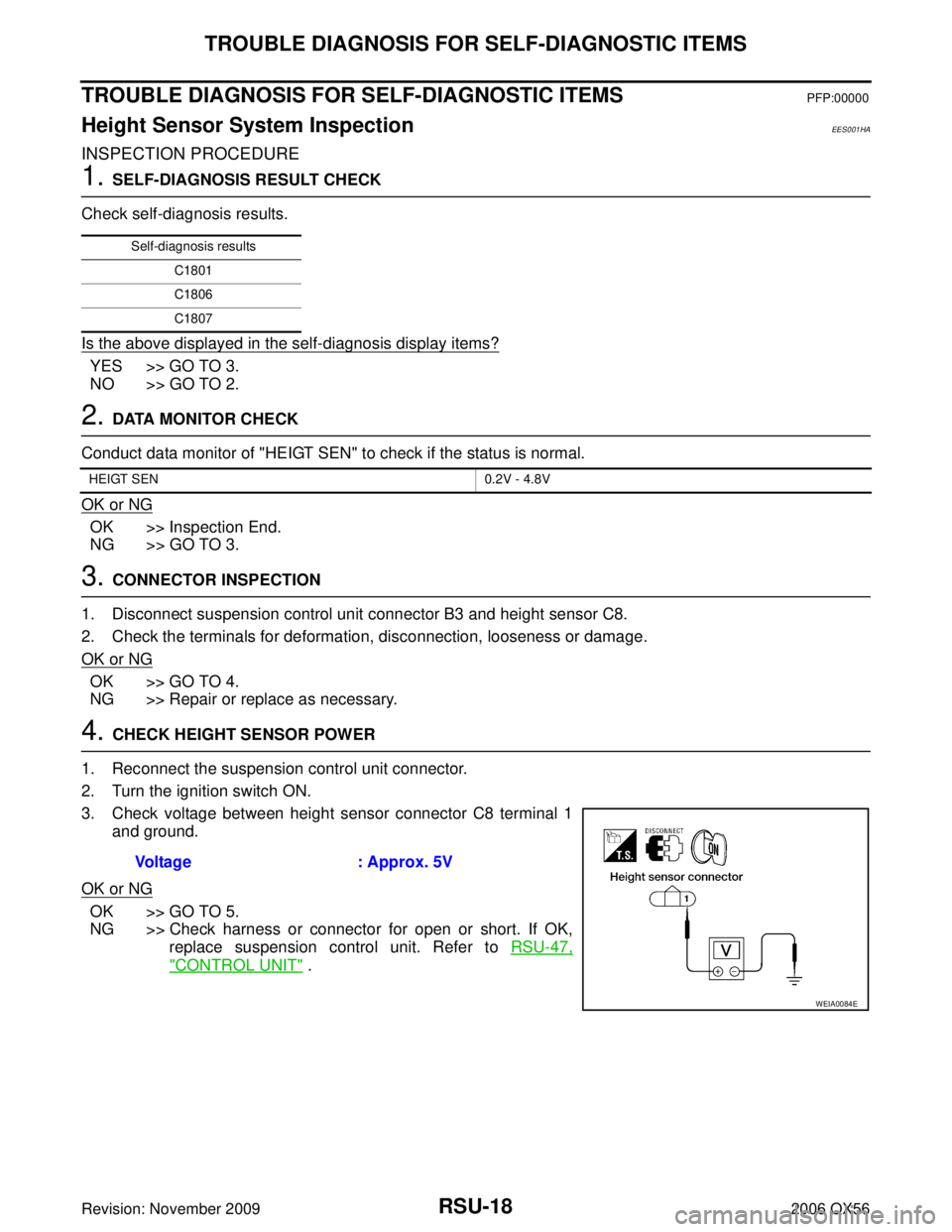
RSU-18
TROUBLE DIAGNOSIS FOR SELF-DIAGNOSTIC ITEMS
Revision: November 20092006 QX56
TROUBLE DIAGNOSIS FOR SELF-DIAGNOSTIC ITEMSPFP:00000
Height Sensor System InspectionEES001HA
INSPECTION PROCEDURE
1. SELF-DIAGNOSIS RESULT CHECK
Check self-diagnosis results.
Is the above displayed in the self-diagnosis display items?
YES >> GO TO 3.
NO >> GO TO 2.
2. DATA MONITOR CHECK
Conduct data monitor of "HEIGT SEN" to check if the status is normal.
OK or NG
OK >> Inspection End.
NG >> GO TO 3.
3. CONNECTOR INSPECTION
1. Disconnect suspension control unit connector B3 and height sensor C8.
2. Check the terminals for deformation, disconnection, looseness or damage.
OK or NG
OK >> GO TO 4.
NG >> Repair or replace as necessary.
4. CHECK HEIGHT SENSOR POWER
1. Reconnect the suspension control unit connector.
2. Turn the ignition switch ON.
3. Check voltage between height sensor connector C8 terminal 1 and ground.
OK or NG
OK >> GO TO 5.
NG >> Check harness or connector for open or short. If OK, replace suspension control unit. Refer to RSU-47,
"CONTROL UNIT" .
Self-diagnosis results
C1801
C1806
C1807
HEIGT SEN 0.2V - 4.8V
Voltage: Approx. 5V
WEIA0084E
Page 2858 of 3383
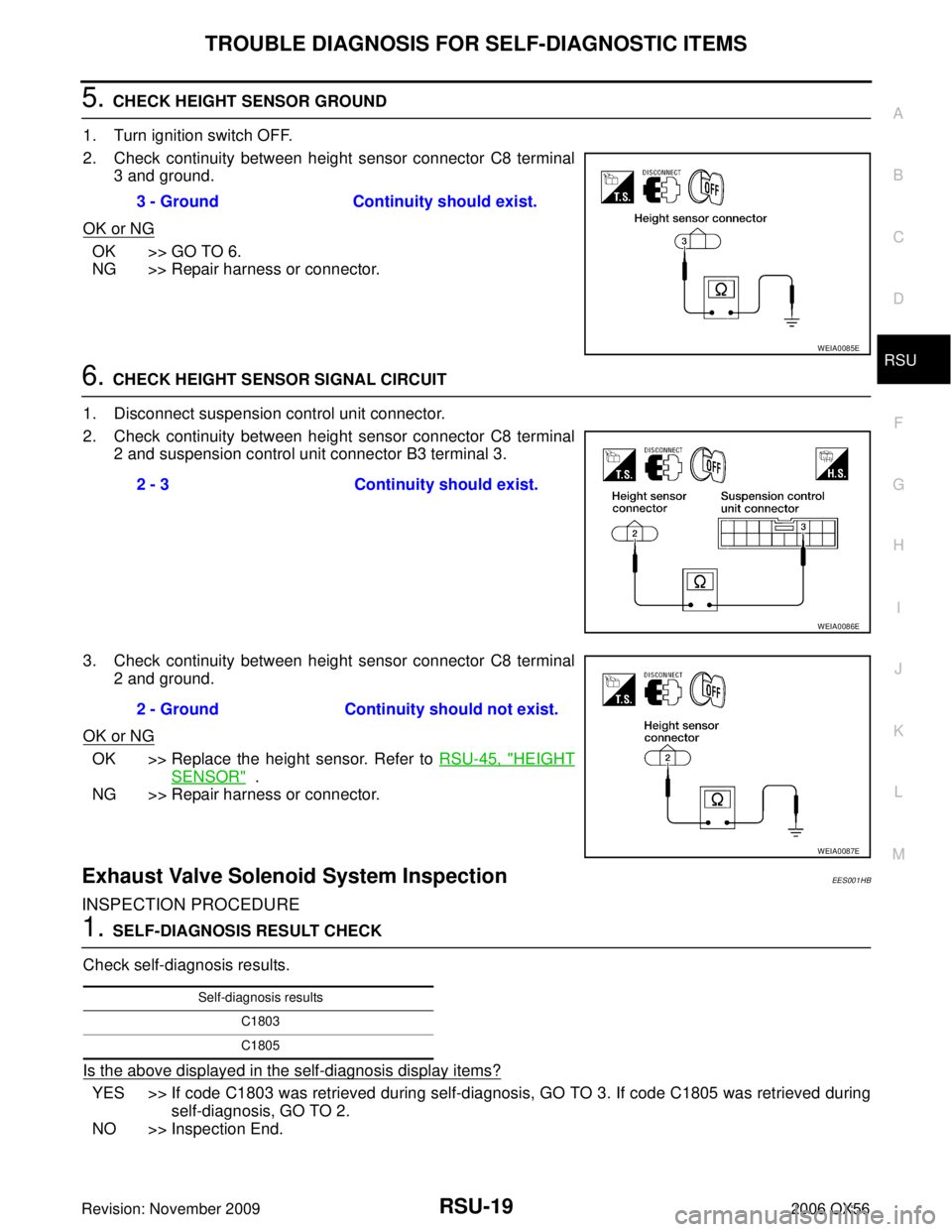
TROUBLE DIAGNOSIS FOR SELF-DIAGNOSTIC ITEMSRSU-19
C
DF
G H
I
J
K L
M A
B
RSU
Revision: November 2009 2006 QX56
5. CHECK HEIGHT SENSOR GROUND
1. Turn ignition switch OFF.
2. Check continuity between height sensor connector C8 terminal 3 and ground.
OK or NG
OK >> GO TO 6.
NG >> Repair harness or connector.
6. CHECK HEIGHT SENSOR SIGNAL CIRCUIT
1. Disconnect suspension control unit connector.
2. Check continuity between height sensor connector C8 terminal 2 and suspension control unit connector B3 terminal 3.
3. Check continuity between height sensor connector C8 terminal 2 and ground.
OK or NG
OK >> Replace the height sensor. Refer to RSU-45, "HEIGHT
SENSOR" .
NG >> Repair harness or connector.
Exhaust Valve Solenoid System InspectionEES001HB
INSPECTION PROCEDURE
1. SELF-DIAGNOSIS RESULT CHECK
Check self-diagnosis results.
Is the above displayed in the self-diagnosis display items?
YES >> If code C1803 was retrieved during self-diagnosis, GO TO 3. If code C1805 was retrieved during self-diagnosis, GO TO 2.
NO >> Inspection End. 3 - Ground
Continuity should exist.
WEIA0085E
2 - 3 Continuity should exist.
WEIA0086E
2 - GroundContinuity should not exist.
WEIA0087E
Self-diagnosis results
C1803
C1805
Page 2859 of 3383
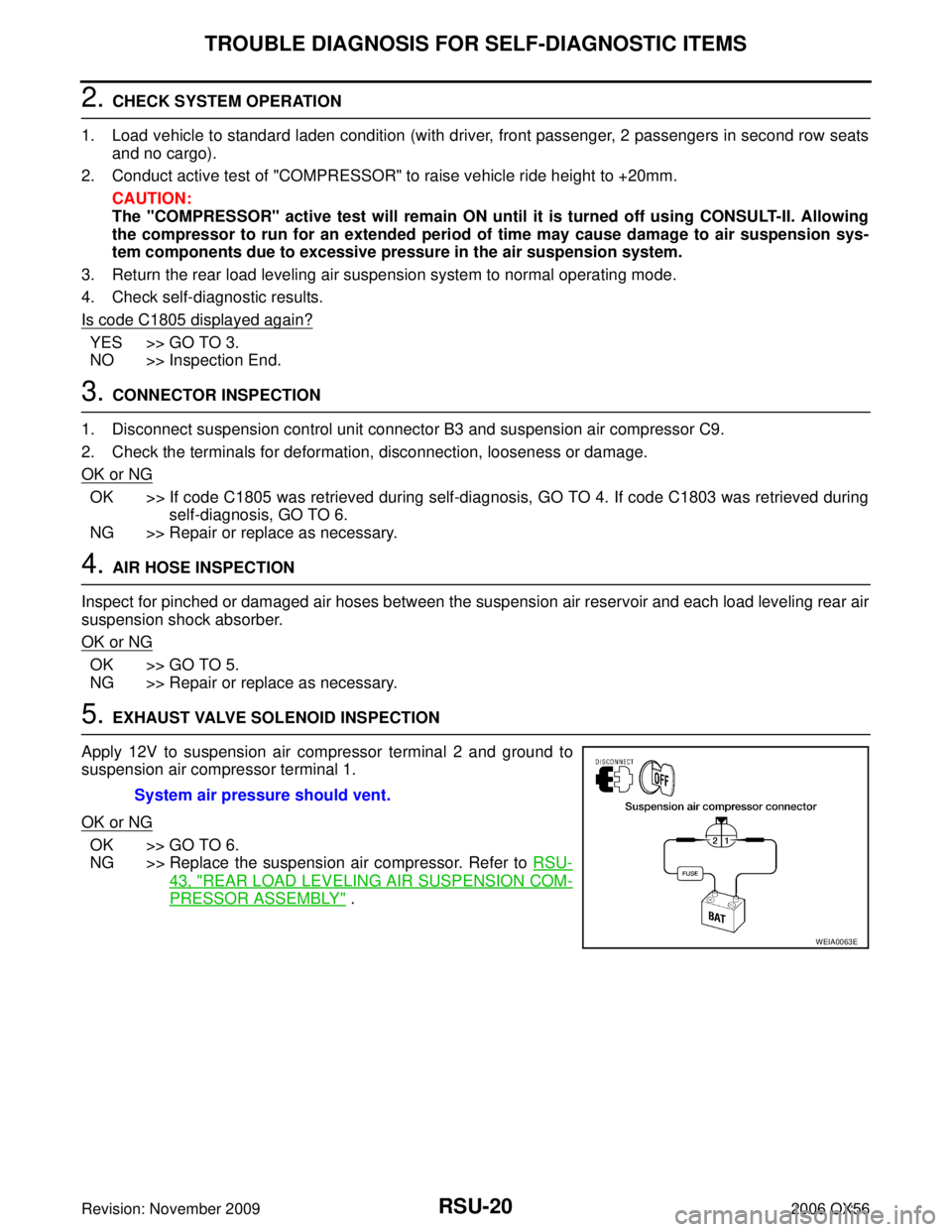
RSU-20
TROUBLE DIAGNOSIS FOR SELF-DIAGNOSTIC ITEMS
Revision: November 20092006 QX56
2. CHECK SYSTEM OPERATION
1. Load vehicle to standard laden condition (with driver, front passenger, 2 passengers in second row seats and no cargo).
2. Conduct active test of "COMPRESSOR" to raise vehicle ride height to +20mm. CAUTION:
The "COMPRESSOR" active test will remain ON until it is turned off using CONSULT-II. Allowing
the compressor to run for an extended period of time may cause damage to air suspension sys-
tem components due to excessive pressure in the air suspension system.
3. Return the rear load leveling air suspension system to normal operating mode.
4. Check self-diagnostic results.
Is code C1805 displayed again?
YES >> GO TO 3.
NO >> Inspection End.
3. CONNECTOR INSPECTION
1. Disconnect suspension control unit connector B3 and suspension air compressor C9.
2. Check the terminals for deformation, disconnection, looseness or damage.
OK or NG
OK >> If code C1805 was retrieved during self-diagnosis, GO TO 4. If code C1803 was retrieved during self-diagnosis, GO TO 6.
NG >> Repair or replace as necessary.
4. AIR HOSE INSPECTION
Inspect for pinched or damaged air hoses between the suspension air reservoir and each load leveling rear air
suspension shock absorber.
OK or NG
OK >> GO TO 5.
NG >> Repair or replace as necessary.
5. EXHAUST VALVE SOLENOID INSPECTION
Apply 12V to suspension air compressor terminal 2 and ground to
suspension air compressor terminal 1.
OK or NG
OK >> GO TO 6.
NG >> Replace the suspension air compressor. Refer to RSU-
43, "REAR LOAD LEVELING AIR SUSPENSION COM-
PRESSOR ASSEMBLY" .
System air pressure should vent.
WEIA0063E
Page 2860 of 3383
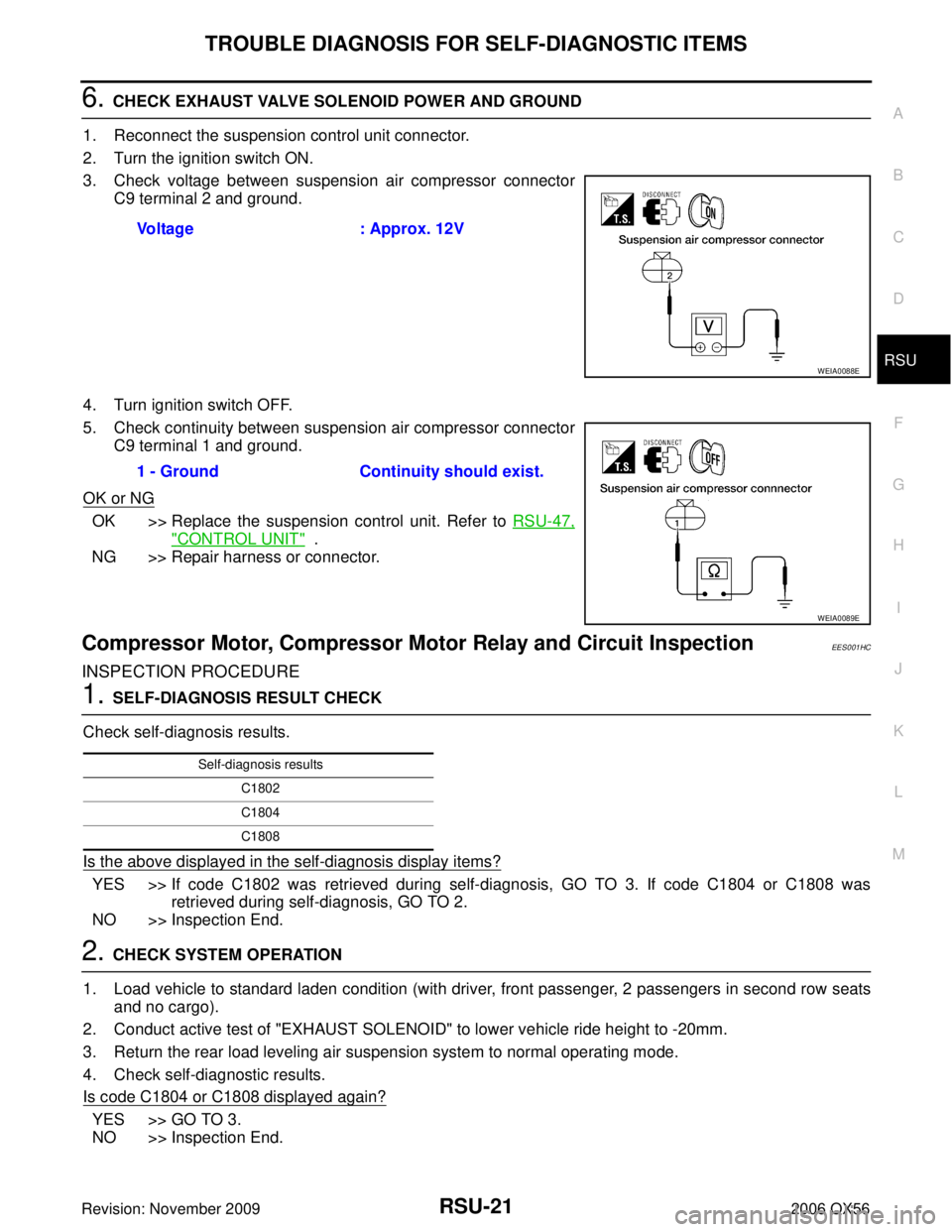
TROUBLE DIAGNOSIS FOR SELF-DIAGNOSTIC ITEMSRSU-21
C
DF
G H
I
J
K L
M A
B
RSU
Revision: November 2009 2006 QX56
6. CHECK EXHAUST VALVE SOLENOID POWER AND GROUND
1. Reconnect the suspension control unit connector.
2. Turn the ignition switch ON.
3. Check voltage between suspension air compressor connector C9 terminal 2 and ground.
4. Turn ignition switch OFF.
5. Check continuity between suspension air compressor connector C9 terminal 1 and ground.
OK or NG
OK >> Replace the suspension control unit. Refer to RSU-47,
"CONTROL UNIT" .
NG >> Repair harness or connector.
Compressor Motor, Compressor Motor Relay and Circuit InspectionEES001HC
INSPECTION PROCEDURE
1. SELF-DIAGNOSIS RESULT CHECK
Check self-diagnosis results.
Is the above displayed in the self-diagnosis display items?
YES >> If code C1802 was retrieved during self-diagnosis, GO TO 3. If code C1804 or C1808 was retrieved during self-diagnosis, GO TO 2.
NO >> Inspection End.
2. CHECK SYSTEM OPERATION
1. Load vehicle to standard laden condition (with driver, front passenger, 2 passengers in second row seats and no cargo).
2. Conduct active test of "EXHAUST SOLENOID" to lower vehicle ride height to -20mm.
3. Return the rear load leveling air suspension system to normal operating mode.
4. Check self-diagnostic results.
Is code C1804 or C1808 displayed again?
YES >> GO TO 3.
NO >> Inspection End. Voltage
: Approx. 12V
WEIA0088E
1 - GroundContinuity should exist.
WEIA0089E
Self-diagnosis results
C1802
C1804
C1808
Page 2864 of 3383
TROUBLE DIAGNOSES FOR SYMPTOMSRSU-25
C
DF
G H
I
J
K L
M A
B
RSU
Revision: November 2009 2006 QX56
4. CHECK GENERATOR SIGNAL INPUT
1. Start the engine.
2. Check voltage between suspension control unit connector B3 terminal 15 and ground.
OK or NG
OK >> Replace the suspension control unit. Refer to RSU-47,
"CONTROL UNIT" .
NG >> Repair the circuit.
CK SUSP Indicator Lamp Stays On When Ignition Switch Is Turned OnEES001HE
1. CARRY OUT SELF-DIAGNOSIS
Carry out self-diagnosis. Refer to RSU-14, "
SELF-DIAGNOSIS" .
Are malfunctions detected in self-diagnosis?
YES >> Refer to RSU-16, "Display Item List" .
NO >> Refer to DI-31, "
WARNING LAMPS" .
Voltage : Approx. 12V
WEIA0071E
Page 2868 of 3383
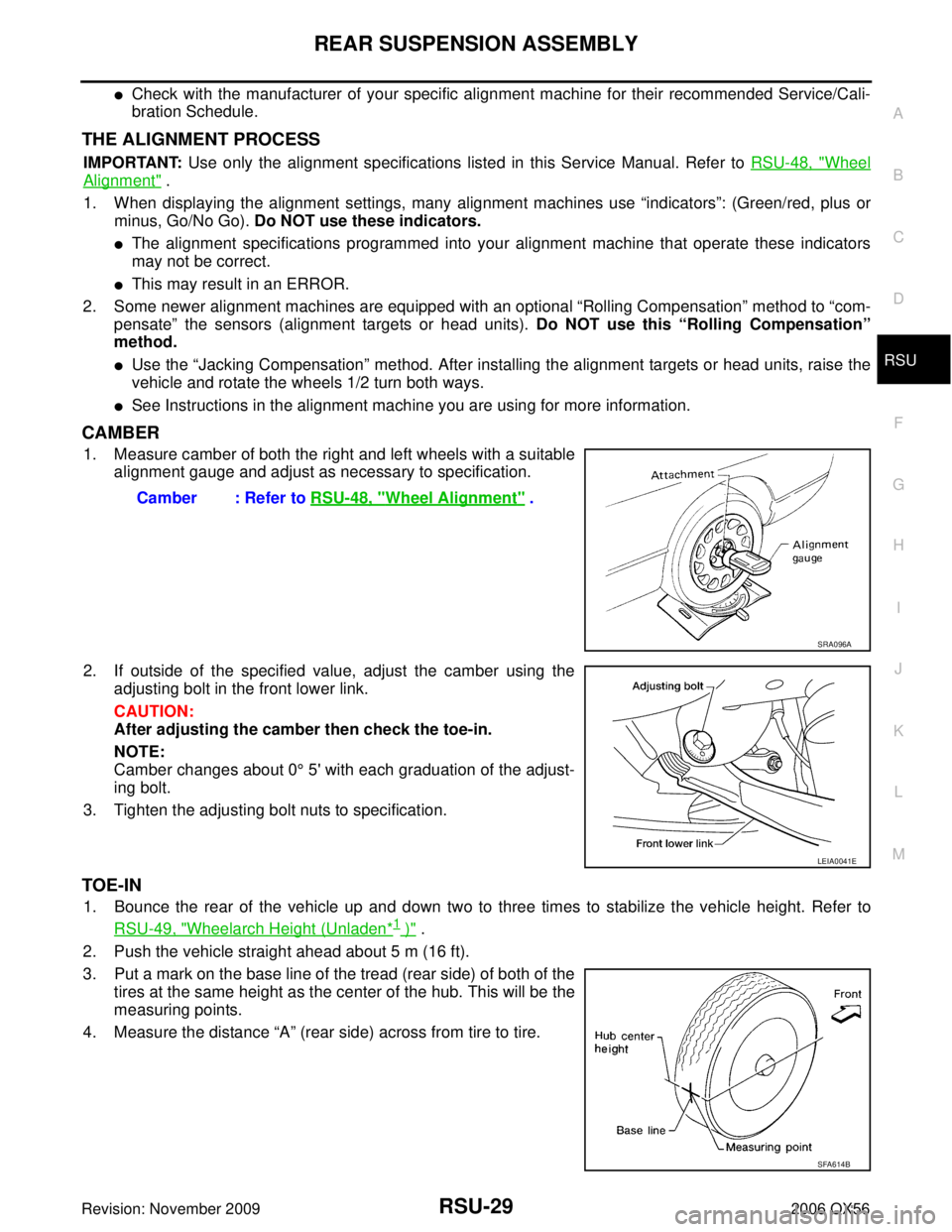
REAR SUSPENSION ASSEMBLYRSU-29
C
DF
G H
I
J
K L
M A
B
RSU
Revision: November 2009 2006 QX56
�Check with the manufacturer of your specific alignment machine for their recommended Service/Cali-
bration Schedule.
THE ALIGNMENT PROCESS
IMPORTANT: Use only the alignment specifications listed in this Service Manual. Refer to RSU-48, "Wheel
Alignment" .
1. When displaying the alignment settings, many alignment machines use “indicators”: (Green/red, plus or
minus, Go/No Go). Do NOT use these indicators.
�The alignment specifications programmed into your alignment machine that operate these indicators
may not be correct.
�This may result in an ERROR.
2. Some newer alignment machines are equipped with an optional “Rolling Compensation” method to “com-
pensate ” the sensors (alignment targets or head units). Do NOT use this “Rolling Compensation”
method.
�Use the “Jacking Compensation ” method. After installing the alignment targets or head units, raise the
vehicle and rotate the wheels 1/2 turn both ways.
�See Instructions in the alignment machine you are using for more information.
CAMBER
1. Measure camber of both the right and left wheels with a suitable alignment gauge and adjust as necessary to specification.
2. If outside of the specified value, adjust the camber using the adjusting bolt in the front lower link.
CAUTION:
After adjusting the camber then check the toe-in.
NOTE:
Camber changes about 0 ° 5' with each graduation of the adjust-
ing bolt.
3. Tighten the adjusting bolt nuts to specification.
TOE-IN
1. Bounce the rear of the vehicle up and down two to three times to stabilize the vehicle height. Refer to RSU-49, "
Wheelarch Height (Unladen*1 )" .
2. Push the vehicle straight ahead about 5 m (16 ft).
3. Put a mark on the base line of the tread (rear side) of both of the tires at the same height as the center of the hub. This will be the
measuring points.
4. Measure the distance “A” (rear side) across from tire to tire.
Camber : Refer to
RSU-48, "
Wheel Alignment" .
SRA096A
LEIA0041E
SFA614B